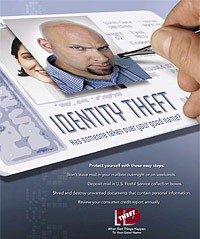In an age of rampant identity theft, we often learn
of many criminals who successfully beat the system.
However, a California task force has successfully
halted the operations of several highly productive
identity theft rings responsible for millions of
dollars in losses.The task force, comprised of inter governmental agencies,
was formed to stem the tide of the most serious identity
theft cases. Cases which, over the past few years, have
evolved from simple identity theft to large scale
identity-theft rings where bank employees, civil servants
and mortgage brokers – people who are instilled with
trust – victimize their customers.
For you to to gain an insider's view behind how serious
identity theft rings operate and threaten your financial
safety, here's a few excerpts from many successful
operations recently busted by the crime task force:
Operation Paper or PlasticOperation Paper or Plastic focused
on members of a widespread identity theft ring who
purchased tax refund checks and credit cards
that had been stolen from the mail. The identity
theft ring, which allegedly was run by a Las Vegas,
Nevada
man manufactured counterfeit identification
cards, which allowed members of the ring to
cash the
stolen tax refund checks and to use the stolen
credit cards for merchandise and cash advances at
casinos.
Operation Paper or Plastic resulted in
20 defendants
for allegedly causing more than
$1 million in lossesover four years.
Operation French FryIn this case,
waiters at over 100 areas restaurantsare charged with "skimming" – or collecting encoded
information – from customers' Washington Mutual
and Wells Fargo Bank ATM cards. Other defendants
are charged with
restriping their own ATM cardswith the stolen information and obtaining
new PINnumbers that allowed them to access the bank
accounts.
More than
150 accounts were compromised by the ring,
which caused losses of more than
$1 million.
Undisclosed Operation NameA Huntington Beach man who
advertised within the
Wall Street Journal pretending to be a would be
customer attempting to locate businesses for sale used
information fraudulently gained from the businesses, as
well as personal information belonging to the owners, to
defraud banks and other lenders.
This identity thief would then
open up fake business
offices, secure lines of credit under the business names,
and then
illegally obtain merchandise and cash.
All told, this identity thief was responsible for more than
$1.5 million in losses.
Undisclosed Operation NameThis identity thief opened more than
70 credit
accounts, mostly under
false names, and then used
the credit cards to take cash advances and transfer
funds among other credit cards and bank accounts.
This Santa Ana identity thief specialized in the
use of
stolen Social Security numbers (ssn)
to defraud lenders.
As a result this identity thief is facing up to 35
years in prison for his role in generating over
$700,000 in credit card losses.
Serious criminals, serious losses for consumers and
financial lenders. And in these few cases, out of
the thousands which take place across America each
month, a few well organized identity thieves have
been removed from threatening consumer safety.
But, you can be assured for every identity thief
stopped by the crime force
there are countlessothers still out there operating quietly andeffectively in destroying innocent American's
financial futures. Even more daunting are
the
internationally based identity theft ringswhich combine the use of locally based criminals
with a world wide internet reach to trade your
stolen information on fraud exchange web sites,
seemingly
beyond the grasp of local or
government law enforcement.
So,
our tip for today is to help crime fighters
stop these sophisticated identity theft rings
from victimizing you. Get
active credit andbank monitoring so you will instantly know
when suspicious activity takes place in your
name.
Special endnote:One of our editors recieved (4) alerts to her
wireless phone within the past week as part of
a personal test to gauge the effectiveness of
her credit monitoring service.
It was no cause for alarm, however, as her
test coincided with her
opening up a newcredit card account and then immediatelytransferring the balance from an older
account she planned to close down.
Her test was designed to emulate the typeof common identity theft activity used today.The three alerts she was
automatically notifiedabout as planned were:
- A credit file inquiry made by the new card company
- A new credit card account opened in her name
- A balance increase of $1,141 which triggered
- A balance increase alert of 323%
The test was successful and just illustrates
had an identity thief, like the ones from
the crime rings above been stealing from
her, she would have instantly been notified
via text messages on her cell phone while
at work.
She would then have ample time to contacther credit card or bank companies to filea fraud alert and avoid the charge losses.Identity theft prevention can work for you.
Final note, excerpts of today's post were provided
courtesy of the U.S. Attorney's office.



















